In five years, the Air Force will lack sufficient fighters to meet the basic requirements of the national military strategy. The inventory in 2013 will dip below 2,250, the minimum needed for meeting national needs, and it won’t rebound for a long while.
This is going to happen. Indeed, it is already too late to avoid the crisis. And without intervention some time soon, the weakness will continue for decades.
The crisis will be brought about by two separate but interrelated factors—massive retirements of worn-out or obsolete fighters, and failure to provide sufficient numbers of modern replacements. The combination of the two will produce rapid shrinkage of the inventory in years just ahead.
The Air Force calls 2,250 fighters “the required force.” What USAF actually will possess a few years hence is the “program force.” This will be the result of the dramatically underfunded fighter acquisition plan foisted on USAF by Pentagon leaders.
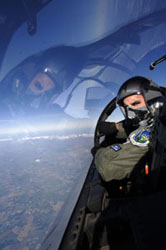 |
Capt. Michael Jokhy checks six in an F-15E on his way back to RAF Lakenheath, Britain. (USAF photo by MSgt. Lance Cheung) |
The number 2,250 was developed in the aftermath of the Quadrennial Defense Review of 2006. This is the air armada USAF’s leaders say will be needed to fight two major regional wars more or less simultaneously, fill out the 10 rotational air and space expeditionary force (AEF) units, and meet other demands such as providing forward presence.
The number also reflects USAF’s most up-to-date analysis about the nature of future battlespaces, which it warns will be increasingly deadly to so-called “legacy” aircraft, such as the F-15 and F-16. It’s the number needed to be able to win with “acceptable” losses, a senior USAF official said.
Today’s Air Force inventory comprises about 2,400 fighter aircraft. In many cases, service lives already extend well beyond original dates. The fleet, as a result, is getting smaller at a rapid rate.
-
In 2008, USAF will retire 35 F-16s, 32 F-15s, and its last 42 F-117 stealth aircraft.
Air Force leaders describe 2013 as the crossover year. Numbers will crash right through the 2,250-fighter floor and then keep on falling for another two decades.
In the Air Force view, the window of vulnerability extends from today through the early 2020s, when more than half of USAF’s fleet will be newer, fifth generation F-22 and F-35 fighters.
Even then, however, the service still will be flying a significant number of F-15s and F-16s, some of them more than 40 years old.
A “High Risk” Plan
Moreover, intelligence analysts expect that foreign nations—China and Russia specifically—will by the early 2020s have fielded not one but two new fifth generation fighters comparable to the best in the Air Force stable. These and other potential adversaries also will have sophisticated ground-based air defenses. Even today, those modern air defenses are considered deadly to legacy fighters.
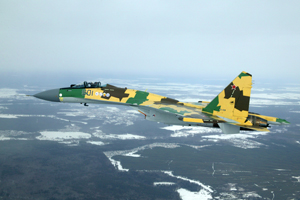 |
A Russian test pilot takes off in a new Su-35, Russia’s newest fighter. (Sukhoi photo via Piotr Butowski) |
The current fighter acquisition plan is “high risk,” said Maj. Gen. Mark T. Matthews, chief of requirements at Air Combat Command, Langley AFB, Va.
“We think … we’re already at a point where, in certain environments, we can’t take the F-15 [and] F-16 into the battlespace” without losing aircraft in battle at rates “higher than what we’ve historically ever been willing to take,” Matthews said in an interview.
The Air Force long expected to replace its F-16s and A-10s with F-35s at the rate of about 110 a year, which would have seen the force modernized by 2030. Instead, its last two budgets have forecast a purchase rate for F-35s at only 48 per year, meaning the buy of 1,763 won’t be completed until 2050. The old fighters will retire long before that, however, leaving a deep deficit in the number of fighters USAF fields.
“We’d like to see it up to 110 aircraft a year,” Matthews said. “In fact, it actually needs to get up in the outer years closer to 135 aircraft per year on F-35 production to meet what we see as being the strategy-required force.”
Matthews said it’s important to understand that combat relevancy, and not just age of the aircraft, is the key consideration. Simply carrying out another service life extension program—a structural upgrade, along with some capability enhancements—won’t do much good.
“If you were to SLEP, you would delay” dropping below 2,250, “but you wouldn’t delay it by much. Maybe about three years or so, out to around 2016, 2017.” After that, the shortfall would take hold and “the gap would continue to grow.”
Matthews said, “It comes up pretty quickly—faster than most people realize.”
The Air Force has been hoping that it could win approval to forestall the coming drop-off in fighter levels by continuing production of the F-22 beyond Fiscal 2009. The F-22 buy has been capped at 183 aircraft by Pentagon leaders in what all concede was a move prompted by finances and not strategy.
Last fall, 96 members of Congress demanded that Deputy Defense Secretary Gordon England provide a rationale for halting F-22 production at 183 aircraft, especially since they had been informed that numerous studies had validated a need for far more than the capped level.
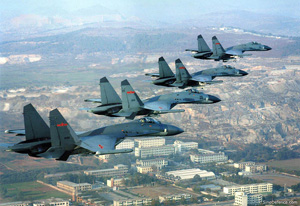 |
Four Chinese J-11s, the licensed copy of Russia’s Sukhoi Su-27SK fighter, fly on a training mission. (Photo via SinoDefence.com) |
According to an Air Force briefing delivered to Congressional staffers in February, there were numerous fighter studies in the period 2001-07. All but one, including an outside look for the Pentagon by the consulting firm of Whitney, Bradley, and Brown, found a need for at least 277 F-22s, and most confirmed the Air Force’s own number of 381.
A Debatable Finding … At Best
Only one study, “Joint Air Dominance,” found sufficient combat power in a 183-Raptor fleet. That study, conveniently, was produced by the Office of the Secretary of Defense—the center of anti-F-22 sentiment.
Joint Air Dominance found that a fleet of 265 F-22s wasn’t all that more effective than the smaller one. It found that, in various scenarios, the power of the F-22 was vitiated by the lack of F-35s, which had been deleted to pay for more Raptors.
How did OSD interpret this result? It concluded that the F-35 was the more effective machine, and therefore was the superior investment.
This was, to say the least, debatable. The Air Force has always said that the two aircraft are complementary, and both are needed to achieve victory in future battles.
“They are not interchangeable,” Maj. Gen. Jeffrey R. Riemer, F-22 program executive officer, said at an industry symposium in February. The F-22, he said, provides air dominance, which is the clearing of enemy fighters and the ability to transit enemy airspace with impunity, by virtue of its stealth and supercruise speed. The F-35, he said, offers “the persistent force” to linger in the battlefield and strike targets far and wide.
Combined, they make possible all other aspects of US airpower—intelligence-surveillance-reconnaissance, airlift, and the ability to roam at will over the battlefield.
The two aircraft are optimized for different roles. Although a credible dogfighter, the F-35 won’t be able to clear the skies the way the F-22 does, but is more than up to the stealthy strike tasks required for a “backbone of the force” fighter like the F-16 it replaces.
Defense Secretary Robert M. Gates said that 183 F-22s—or 187, if the Pentagon gets four additional airplanes as part of its supplemental funding request—is “probably the right number.” He said he worries “that if the F-22 production is expanded, that it will come at the expense of the [F-35].”
Gates’ deputy, England, wrote back to the 96 Congressmen that the Pentagon believes that the F-35 is the better buy. He again was framing the issue as an either-or decision. Why is anyone’s guess.
The funding problem in fighters dates back to the 1990s and early 2000s, when there was a major disruption to the Air Force’s modernization plans. The F-22 was supposed to be bought in quantities of up to 48 a year, closing out in about 2012. It was to be followed immediately by production of the F-35, with no funding overlap and no break in Air Force fighter production. However, delays in the F-22 mounted—some demanded by Congress, some by the Clinton Administration, some due to technical holdups. By the time the Raptor was ready to be produced in large lots, the US was at war in Afghanistan and Iraq, and the required number—381—was thrown overboard by the Bush Administration as unaffordable, regardless of strategy. The F-22 was downsized to a program of just 183 aircraft, and would end production before the F-35 began production in quantity. Studies which validated any larger number were ignored, classified, and shelved.
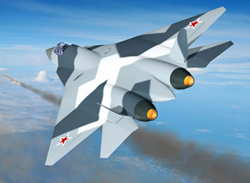 |
This illustration shows a Sukhoi T-50, also called a PAK FA, in flight. It was designed to compete with USAF’s F-22 fighters. (Illustration via Piotr Butowski) |
Rep. John P. Murtha (D-Pa.), chairman of the House Appropriations defense subcommittee, told reporters in February that he wasn’t satisfied with the Administration’s fighter procurement plans. He said there may be a perception around the world that the US is weak “and the reason is because everything is getting older.” He said the Air Force hasn’t been buying new aircraft and is “wearing … out” the old iron in the two ongoing wars in Southwest Asia. He judged the Air Force to be “in bad shape” and said he would take up extended fighter buys with his colleagues.
Although many F-15s were restored to flight status in mid-February, the defect found to have caused a recent crash may have been a harbinger of other problems that may erupt as the Air Force tries to fly a fighter for 50 years—something that’s never been done. In a press conference to explain the F-15’s woes, Gen. John D.W. Corley, the ACC commander, told reporters, “We may never get back to full health with this fleet.”
Due in large part to doubts about F-22 production, some 177 F-15s will be kept in the inventory into the 2020s. The aircraft will get structural fixes to stretch their years of service and a new radar, but they will be consigned to those battles where stealth and superspeed are not needed.
Some of the “new” fifth generation fighters may start to age out of the fleet before 2030. The first all-up F-22 fighter rolled off the assembly line in 1998, and is already 10 years old. The F-22 has a design life of some 30 years. Matthews said the Air Force has begun to think about what will replace the F-22, since it took 20 years to get the Raptor from drawing board to ramp.
Regardless of the annual buy rate, the Air Force has stuck to a production objective of 1,763 F-35s. It simply has to buy that number to have enough fighters to go around.
“Some people say, ‘Well, you’re getting a more capable aircraft, so the numbers need to come down,’ ” Matthews noted. “We are getting a more capable aircraft, that’s true, but there’s a certain level … you can’t go below just because of geography. I can’t be in two places at the same time.”
He also noted that not buying enough F-22s will create a permanent condition wherein the F-22s are a high demand-limited availability asset. Regional commanders demanding them will be perpetually shortchanged, and not just in air superiority; one-half squadron of F-22s will essentially be substituting for “two and a half squadrons per AEF” of today’s aircraft.
Matthews acknowledged that some USAF critics believe so-called “short-range fighters” are the wrong place to put scarce procurement dollars—that if China and Russia are the emergent and re-emergent threats, then the Air Force ought to invest in long-range bombers instead.
However, said Matthews, “Many of the types of conflicts that we’re looking at are not going to be amenable to relatively modest fleet sizes operating from great distances.” A small fleet of bombers simply couldn’t match the sortie rate of fighters, and access at foreign operating bases will still be needed.
A Critical Part of CONOPS
“The mix is highly sensitive to what kind of assumptions you’re making about what the mission sets are and what type of threat you’re going to get,” Matthews noted. The 2,250 fighter fleet number is the one that offers the best combination for most scenarios.
Likewise, Matthews said, it’s not sufficient merely to load up on stealthy standoff missiles as a substitute for fighters.
“You can never fully … get around the requirement to have a stand-in capability, just because of the dynamic nature of the battlefield,” Matthews said. He added that standoff weapons are “a critical part of all our concepts of operation” but will never substitute for a larger, flexible platform.
In the debate, the Air Force doesn’t have to assume that adversary fighters will get stronger. It’s already happening.
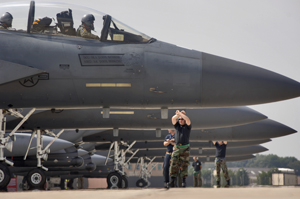 |
Crew chiefs marshal F-15s to parking spaces at RAF Lakenheath. These aircraft belong to the 492nd Fighter Squadron. (USAF photo by MSgt. Lance Cheung) |
Critics of the Air Force’s fighter modernization plans often put forth an argument that the F-22 in particular was a Cold War weapon designed for a threat that “never materialized,” citing the fact that the Soviet Union went out of business in 1991. Pierre M. Sprey, an Air Force gadfly who had a hand in designing the F-16, recently declared air-to-air combat a thing of the past.
Apparently, foreign air forces didn’t get the memo. Russia never paused in developing, building, deploying, and selling its best fighter, the Su-27 Flanker (and derivatives), one of the best-selling and most capable combat aircraft in the world. About 1,200 Flankers in a bewildering array of variants have been deployed or sold to 15 countries, including China, India, Venezuela, and Belarus.
As recently as the late 1990s, the Air Force F-15C was still considered the best all-around fighter in the world, owing to its radar range and aerobatic abilities. However, according to internal USAF documents, the F-15C is now second best to the Flanker in practically every important comparison, such as radar, weapons, range, processors, and maneuvering. Plus, most Flankers are less than half the age of the F-15.
Flankers boast thrust vectoring, some variants have close-coupled canards, and nearly all have Digital Radio Frequency Memory jammers on wingtip pods, which are adept at confusing older-style radars such as those on most F-15s and F-16s. They make the Flanker appear to be somewhere it isn’t.
The Air Force plans to upgrade many of its F-15s with active electronically scanned array radars, or AESA, which will buy back some of the Eagle’s detection range, but such improvements won’t make the F-15 any younger or more agile. The recent F-15 grounding, due to cracks in supposed life-of-the-aircraft parts, was evidence enough that the fleet is tired after 17 years of continuous combat.
That the Flanker has matched the F-15 was borne out in Cope India exercises a few years ago, in which US F-15s were defeated by India’s Flanker-led forces.
Russia’s Sukhoi aircraft company announced late last year that it will flight-test a fifth generation aircraft of its own design in 2009, and start deliveries to the Russian Air Force in 2015. Sukhoi said the aircraft, known as the T-50, will be comparable to the F-22 and is already being fabricated. Last November, Russia announced it was in negotiations with India’s Hindustan Aeronautics Limited to jointly develop and build the aircraft.
Claims of a Russian fifth generation fighter have been made several times in the last 15 years, and all have proved to be wishful thinking. However, Russian President Vladimir V. Putin last year pledged to apply a good chunk of his country’s new oil wealth toward making Russia’s aerospace products dominant in the market.
Chinese military white papers have urged the development of aircraft to equal those in USAF, and Air Force analysts say China is indeed making preparations to build an F-22-like aircraft, called the XJ-12, late in the next decade.
The Flanker is not the only formidable air-to-air threat faced by the Air Force today. Even the “second string” fighters in Russia, China, India, and other countries are rapidly advancing. The MiG-29 is considered an aerodynamic match for the F-16 and F-18 and has been sold to 34 countries, including Iran, Syria, and North Korea.
Fighting in an Enemy’s Airspace
China has now fielded its own indigenously built counterpart of the F-16, called the J-10, and is jointly developing the FC-1 or JF-17 with Pakistan. The JF-17 is externally similar to the F-16 and F-20 Tigershark and shows potential to be a world-class point defense fighter.
Raw comparison of fighter numbers is not useful in gauging USAF’s needs. With a fleet of fewer than 200 Raptors, USAF will be able to go to war with 125 or so, at most. The rest will be in maintenance, training, or test.
Moreover, USAF fights in an enemy’s airspace. The first squadrons in wartime deployments will find themselves outnumbered by some of the larger air forces in the world, operating from their own home bases, demanding that the Raptors achieve a heavily lopsided kill ratio. They will have to be many times better than the aircraft they face in battle just to survive.
Fighters represent just part of the threat equation. Integrated air defense systems, or IADS, are proliferating, and in recent years, the “threat rings” around adversary targets are expanding, USAF documents show. The SA-20 system, in service with Russia and China, already offers a detection range of 124 miles. A near-term improvement, the SA-21, will have a detection and engagement range of more than 230 miles. In practical terms, such a system deployed by China on the edge of the Taiwan Strait would put any aircraft taking off from Taiwan immediately within range of China’s surface-to-air missiles. Naval variants of these air defense systems, such as Russia’s SA-N-20 and China’s HHQ-9, are also making it harder to engage surface vessels. They also have greater capability against stealthy aircraft and cruise missiles.
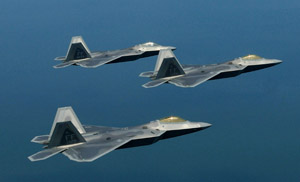 |
Three F-22 Raptors fly in formation. Even when the F-22 buy is complete, USAF still will be flying large numbers of geriatric F-15s and F-16s. (USAF photo by SSgt. Samuel Rogers) |
In addition, both Russia and China are fielding new air-to-air missiles with active radar. The Russian AA-12 and its Chinese counterpart, the PL-12, have been dubbed the “AMRAAMski” because of their close patterning on the American Advanced Medium-Range Air-to-Air Missile (AMRAAM), which has never been beaten in combat. “We’re real concerned with … their continued advancements,” Matthews allowed.
Some of the Pentagon’s leadership may be thinking that the F-22 would only be useful for the opening hours of a future conflict, an assumption that would be false, Matthews said.
“It’s wrong-minded to think that suddenly, after four days,” an air defense threat will be beaten down and never pose a problem again, he said. The Air Force experience in Serbia in 1999 showed that adversaries learn from others’ mistakes, and that surface-to-air missiles lurked undestroyed and were still problematic throughout that conflict.
“A lot of these surface-to-air missile systems … are mobile. We don’t expect them all just to sit there and radiate constantly until we destroy them. They’ll move around; they’ll hide.”
Gates, in his testimony to Congress, said he sees little chance of a tangle with a “near peer” country “over the next four or five years,” leading him to be satisfied that the F-22 buy of 183 aircraft is enough.
However, Matthews said, “It’s important … that we not get focused too much on what the next four years of warfare might be.” The next half-decade may be reasonably predictable, “but we sure don’t know what the next 34 years of warfare is going to be.”
He added that it is hard to answer one of the biggest questions: How many conflicts have been avoided because no one wanted to take on the Air Force’s fighters
“You can never really quantify what that is, but … certainly … it was a key element of our winning the Cold War, preventing a lot of other major conflicts, and deterring a lot of other bad things.” Matthews said USAF wants to “make sure we’re doing the same thing for the next 30 years.”
The question is how to do it with a numerically deficient fighter force.